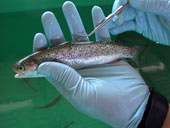forum
library
tutorial
contact

Dams Not Main Cause
of Salmon Collapse, Study Says
by James OwenNational Geographic News, October 27, 2008
|
the film forum library tutorial contact |

|
Dams Not Main Cause
by James Owen |
 The first ever tracking of young Pacific salmon ocean migrations suggests the main barriers to their survival aren't river dams-but lethal obstacles at sea.
The first ever tracking of young Pacific salmon ocean migrations suggests the main barriers to their survival aren't river dams-but lethal obstacles at sea.
The controversial finding, which makes use of the latest in fish-tagging technology, investigated the seaward migration of Chinook salmon and steelhead-a type of trout-in North America's two largest West Coast rivers.
Juvenile fish equipped with tiny sound-emitting tags were released in 2006 in the headwaters of Columbia River, which has numerous hydropower dams on its system, and Canada's dam-free Fraser River.
A team tracked the fish during the "smolt" stage of their life cycle, when the juvenile fish begin to migrate-as they headed for the Pacific Ocean and distant feeding waters off Alaska.
Salmon reach maturity in the sea, then later swim back upstream to their hatching site to spawn.
Dramatic declines in Pacific salmon and steelhead in the Columbia system have been blamed in part on eight hydropower dams on the Snake.
Conservation groups are campaigning to have four of these dams removed.
But David Welch of Kintama Research, Nanaimo, British Columbia, reports in the journal PLoS Biology that the Columbia's young salmon and steelhead have as good or a better chance of survival as those in the Fraser River.
"This doesn't mean that dams are good for salmon, but it's a very different result than what the science community would have expected," Welch said.
"We'd have expected to see the survival a lot lower [in the Columbia], but we're actually seeing it's somewhat higher," he said.
Navigation Aid
While the new study focused only on the river stage of the smolt migration, mortality levels at sea are also being investigated by the team.
And the researchers note that while 25 to 65 percent of migrating smolts make it successfully through the Snake-Columbia's entire hydropower system, only a tiny fraction-as little as 0.5 percent some years-return as adult salmon.
The findings are based on technology developed by the Pacific Ocean Shelf Tracking (POST) project, which is headed by the Vancouver Aquarium.
Sound signals from almond-size transmitters surgically implanted in the juvenile salmon were picked up by lines of underwater detectors placed along their migration route.
"For the first time we've tracked a critter the size of a hot dog, 1,553 miles (2,500 kilometers) from the Rocky Mountains up to southeast Alaska," said Jim Bolger, executive director of POST, part of the International Census of Marine Life, a global research network.
"One of the other surprises is how quickly they made it-these are the Michael Phelps of small fishes," Bolger said.
Dams Blamed
Ray Hilborn, a professor of fishery sciences at the University of Washington in Seattle, said the new findings will be controversial, not least because hundreds of millions of dollars are spent annually on salmon-driven fisheries issues in the Columbia River.
For instance, dam modifications to assist migrating salmon have led to much-improved survival rates since the 1970s, the study team suggests.
But Hilborn, who wasn't involved in the research, said he isn't surprised by the results.
Plummeting Chinook salmon numbers in the Columbia in the 1980s and 1990s were "often blamed exclusively on the completion of the Snake River dams and ongoing losses from hydropower," Hilborn noted.
But, during the same period, "the Fraser River Chinook declined just as rapidly and just as much," he said. "The Fraser had no dams, so what was the cause there?"
"I believe that everyone now accepts that all the Chinook salmon in the Pacific northwest [apart form Alaska] have been very negatively influenced by ocean conditions," Hilborn said.
Kintama Research's Welch agrees: "My personal judgment is that the real survival problems are out in the ocean, after the fish leave the rivers."
Possible negative factors include ocean warming and changes to salmon prey distribution, increased salmon predation by seals and sea lions, and lethal parasite infestations of wild smolts spread by coastal salmon farms.
Future tagging studies aim to pinpoint where Pacific salmon are perishing at sea, and unravel further mysteries of their migration.
"This really neat new technology allows us for the first time look at questions that were never before possible," Welch, the study author, said.
learn more on topics covered in the film
see the video
read the script
learn the songs
discussion forum
